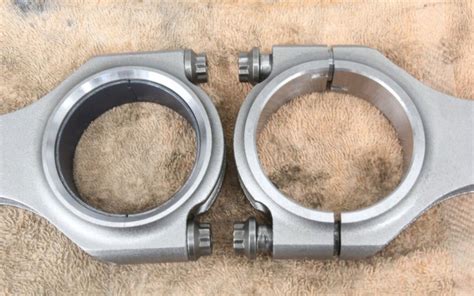Connecting Rod Bearings: Key to Engine Health and Performance
Connecting rod bearings are crucial components that play a pivotal role in maintaining engine efficiency and longevity. These bearings support the connecting rods, enabling the smooth transfer of force between the crankshaft and the pistons. Failure to maintain proper bearing health can lead to catastrophic engine damage. This comprehensive guide delves into the anatomy, function, and maintenance of connecting rod bearings, providing valuable insights to ensure optimal engine performance.
Understanding Connecting Rod Bearings
Anatomy of Connecting Rod Bearings
Connecting rod bearings consist of two identical halves known as the upper bearing and the lower bearing. These halves are typically made of a copper-lead alloy or steel-backed aluminum, featuring a thin layer of bearing material to reduce friction. The bearing material, often composed of tin, lead, or a combination thereof, is bonded to the bearing shell.
Function of Connecting Rod Bearings

The primary function of connecting rod bearings is to support the connecting rod journal, which rotates on the crankshaft. This rotation generates immense pressure, and the bearings provide a smooth, low-friction surface to withstand these forces. Bearings also distribute heat and absorb impact loads, minimizing wear and tear on the connecting rod and crankshaft.

Maintenance of Connecting Rod Bearings
Regular Inspection
Regular inspection of connecting rod bearings is crucial for early detection of any issues. Periodically remove the oil pan and visually inspect the bearings for signs of wear, such as pitting, scuffing, or discoloration. Consult a mechanic if any abnormalities are observed.

Proper Lubrication
Adequate lubrication is paramount for the health of connecting rod bearings. Use high-quality engine oil that meets the manufacturer's recommendations and change the oil and filter at the prescribed intervals. Insufficient lubrication can lead to excessive friction, bearing failure, and engine damage.
Optimal Clearance
Maintaining proper clearance between the connecting rod bearing and the crankshaft journal is essential. Excessive clearance can result in knocking noises and premature bearing wear, while insufficient clearance can cause seizure. Refer to the vehicle's service manual for the correct bearing clearance specifications.
Why Connecting Rod Bearings Matter
Maintaining healthy connecting rod bearings is critical for several reasons:

Engine Performance
Properly functioning bearings minimize friction and enable efficient transfer of force between the crankshaft and the pistons. This ensures optimal engine power, fuel economy, and reduced emissions.
Engine Longevity
Bearing failure can lead to catastrophic engine damage, often requiring extensive and costly repairs. Regular maintenance and care can significantly extend engine life and prevent costly breakdowns.
Reliability
Well-maintained connecting rod bearings enhance engine reliability, reducing the risk of unexpected breakdowns and ensuring peace of mind while driving.
Common Mistakes to Avoid
Neglecting Inspection
Skipping regular bearing inspections can lead to missed problems, potentially resulting in costly repairs or engine failure.
Overtightening Connecting Rod Bolts
Excessive torque on connecting rod bolts can crush the bearings and cause premature failure. Always follow the manufacturer's tightening specifications.
Using Incorrect Bearing Clearance
Improper bearing clearance can lead to knocking noises, bearing wear, or seizure. Consult the service manual for the correct specifications.
Tips and Tricks
Use a Plastigage
Plastigage is a simple yet effective tool for measuring bearing clearance. Place a strip of Plastigage on the bearing surface, tighten the bolts to the specified torque, and then measure the flattened width of the strip to determine the clearance.
Check for Bearing Runout
Connect the connecting rod to the crankshaft and mount a dial indicator on the rod journal. Rotate the crankshaft slowly and observe the dial indicator to check for any bearing runout. Excessive runout may indicate a bent crankshaft or misaligned bearings.
Humorous Stories and Lessons Learned
The "Knock" Lesson
A motorist ignored a persistent knocking noise from his engine, attributing it to a faulty exhaust system. However, upon further investigation, the mechanic discovered that the culprit was worn-out connecting rod bearings, leading to a costly engine rebuild. This taught the driver the importance of promptly addressing unusual engine noises.
The "Lack of Lubrication" Tale
A driver who rarely changed his oil experienced catastrophic engine failure due to lack of lubrication. The connecting rod bearings had seized, causing extensive damage to the crankshaft and pistons. This highlighted the critical importance of regular oil changes and proper engine maintenance.
The "Overtightening" Mishap
An enthusiastic mechanic overtightened the connecting rod bolts, crushing the bearings and resulting in a seized engine. This emphasized the importance of following manufacturer's torque specifications and avoiding excessive force when tightening bolts.
FAQs
-
What are the signs of worn connecting rod bearings?
- Knocking or tapping noises from the engine
- Reduced engine power and fuel economy
- Increased oil consumption
- Visible wear on the bearings during inspection
-
How often should I inspect connecting rod bearings?
- Inspect bearings every 50,000 to 100,000 miles, or as per the manufacturer's recommendations.
-
Can I replace connecting rod bearings myself?
- Replacing connecting rod bearings is a complex procedure that requires specialized tools and knowledge. It is recommended to consult a mechanic unless you have extensive automotive experience.
-
What is the cost of replacing connecting rod bearings?
- The cost varies depending on the vehicle and the severity of the damage. It can range from a few hundred dollars to several thousand dollars.
-
How do I prevent premature connecting rod bearing failure?
- Use high-quality engine oil and change it regularly.
- Maintain proper bearing clearance.
- Avoid lugging the engine or subjecting it to excessive loads.
- Consult a mechanic if you hear any unusual engine noises.
-
What is the recommended bearing material for connecting rod bearings?
- Copper-lead alloy or steel-backed aluminum

